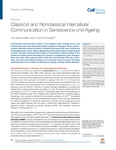Classical and nonclassical intercellular communication in senescence and ageing

Ver/
Use este enlace para citar
http://hdl.handle.net/2183/28622
A non ser que se indique outra cousa, a licenza do ítem descríbese como Creative Commons Attribution-NonCommercial-NoDerivs 4.0 International License (CC-BY-NC-ND 4.0)
Coleccións
- GI-TCMR - Artigos [129]
Metadatos
Mostrar o rexistro completo do ítemTítulo
Classical and nonclassical intercellular communication in senescence and ageingData
2020-06-03Cita bibliográfica
Fafián-Labora JA, O'Loghlen A. Classical and nonclassical intercellular communication in senescence and ageing. Trends Cell Biol. 2020 Aug;30(8):628-639.
Resumo
[Abstract] Intercellular communication refers to the different ways through which cells communicate with each other and transfer a variety of messages. These communication methods involve a number of different processes that occur individually or simultaneously, which change depending on the physiological or pathological context. The best characterized means of intercellular communication is the release of soluble factors that affect the function of neighboring cells. However, there are many other ways by which cells can communicate with each other. Here, we review the different means of intercellular communication including soluble factors in the context of senescence, ageing, and age-related diseases.
Palabras chave
SASP
Senescence
Ageing
Extracellular vesicles
Intercellular communication
Metabolites
Senescence
Ageing
Extracellular vesicles
Intercellular communication
Metabolites
Versión do editor
Dereitos
Creative Commons Attribution-NonCommercial-NoDerivs 4.0 International License (CC-BY-NC-ND 4.0)
ISSN
0962-8924






